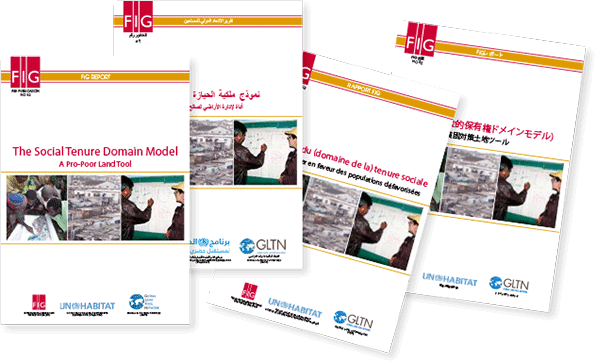News in 2017

|
FIG Publication on STDM now available in 4 languages
April 2017
"The Social Tenure Domain Model - A Pro-Poor Land Tool" is a FIG
Publication written by Dr Chriistian Lemmen. The FIG publication was
published in 2010 and is a co-production between FIG and
UN-Habitat/GLTN.

Most developing countries have less than 30 percent cadastral
coverage. This means that over 70 percent of the land in many countries
is generally outside the land register. This has caused enormous
problems for example in cities, where over one billion people live in
slums without proper water, sanitation, community facilities, security
of tenure or quality of life. This has also caused problems for
countries with regard to food security and rural land management issues.
A model has been developed to accommodate social tenures, termed the
Social Tenure Domain Model (STDM). This is a pro-poor land information
management system that can be used to support the land administration of
the poor in urban and rural areas, which can also be linked to the
cadastral system in order that all information can be integrated.
The security of tenure of people in these areas relies on forms of
tenure different from individual free hold. Most off register rights and
claims are based on social tenures. GLTN partners support a continuum of
land rights, which include rights that are documented as well as
undocumented, from individuals and groups, from pastoralist, and in
slums which are legal as well as illegal and informal.
STDM Workshops
Over several years GLTN and FIG, primarily FIG Young Surveyors, have
held STDM Workshops around the world to encourage and instruct (Young)
Surveyors to use the STDM model. In connection with the FIG Working Week
in Helsinki, Finland another STDM Workshop will be held on 29 May 2017:
http://www.fig.net/fig2017/stdm.htm
Arabic, French and Japanese
The publication has now been translated into the following languages
that are now available in pdf:
The Arabic version was translated by GLTN, reviewed by Saad
Kholoud who was also a great help when the
publication was finalised for print, and published in 2015. The French
version was also translated by GLTN, reviewed by Claire Galpin,
and published 2017. The Japanese version was translated by
Kazuaki Fujii, Japan Federation of Land and House
Investigators’ Associations (JFLHIA) Research Institute and confirmed
with Japan Federation of Surveyors. Mr Kazuaki Fujii
aalso assisted with the layout to ensure a correct language.
A very big thanks to all who have helped with these translations.
25 April 2017
























